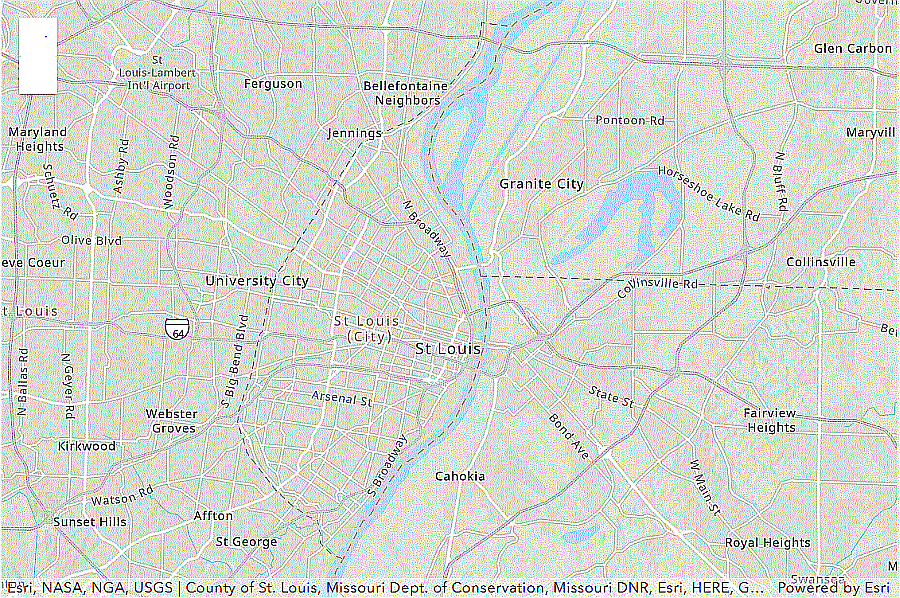St. Louis is the second-largest city in Missouri, and sits on the western bank of the Mississippi River, which forms the state line between Illinois and Missouri. The Missouri River merges with the Mississippi River 15 river miles north of Downtown St. Louis, forming the fourth-longest river system in the world. The first steamboat arrived in the town in 1817. By the 1850s, 5,000 steamboats would travel through the city each year.
St. Louis was founded February 14, 1764 and incorporated in 1822. It is name for Louis IX of France. Pierre Laclede Liguest, recipient of a land grant from the King of France, and his 13-year-old scout, Auguste Chouteau, selected the site of St. Louis in 1764 as a fur trading post. Laclede and Chouteau chose the location because it was not subject to flooding and was near the confluence of the Mississippi and Missouri Rivers.
The fur trade fueled the growth of this Mississippi River town which was the starting point for (1804) and end of (1806) Lewis & Clark’s monumental journey of discovery. There are more au-thentic Lewis & Clark historic sites in the St. Louis area than anywhere in the US.
St. Louis was already a 40-year-old river town when Thomas Jefferson signed the Louisiana Purchase. Explorers Lewis and Clark began their westward trip from the area in 1804.St. Louis heavily influenced the westward expansion.
The first cathedral west of the Mississippi River was built on the St. Louis riverfront and completed in 1834. The Old Cathedral, which replaced a 55-year-old log church, still stands and serves as an active Roman Catholic parish.
The first ironclad boat built in America was constructed in St. Louis shipyards in 1861 for use by the Federal Navy during the Civil War. The vessel was designed by James Bu-chanan Eads, a self-taught engineer who later built the Eads Bridge
The first United States kindergarten was started in St. Louis in 1873 by Susan Blow. Visitors can see her original classroom in the Des Peres School located in the Carondelet neighborhood.
One of the world's first skyscrapers was built in St. Louis in the 1890s. The Wainwright Building wasn’t the tallest building in 1890s America (Chicago and New York had taller). But it was the first skyscraper to look the part, embracing its height with a sheer wall of windows instead of tiered floors or overhanging ledges.
In 1927, a group of St. Louis businessmen gave financial backing to the first solo transatlantic flight from New York to Paris. The pilot was Charles Lindbergh and the plane was named “The Spirit of St. Louis.” A replica of the plane is located at the Missouri History Museum.
St. Louis is riddled with caves. A local tradition says that these caves played a vital role in the Underground Railroad, providing shelter for those fleeing the slave state of Missouri. During Prohibition, the caves made natural bootlegger vaults. Even after the repeal, many city residents found refuge in these underground spaces, which were cool in summer and warm in winter.
Over the 20th century, hidden warrens that had once provided secret taverns and beer cellars metamorphosed into underground churches, warehouses, nightclubs, roller rinks, and even a 300-seat theater. The caves below St. Louis were widely used for at least 10,000 years.
St Louis Today
St. Louis is a historic metro area of 2.8 million with a family-friendly reputation and tight-knit communities. The city of St Louis has a populationof 316,030 people.

The cost of living in St. Louis is affordable. St. Louis has stunning historical homes, grandiose cultural institutions, first-class schools, sprawling parks and a packed events calendar that you might expect of a big city. St. Louis has 79 different neighborhoods, each with its own distinctive style and characteristics. Many of these neighborhoods have very active community organizations and associations. City of St. Louis, MO: Official Website |
